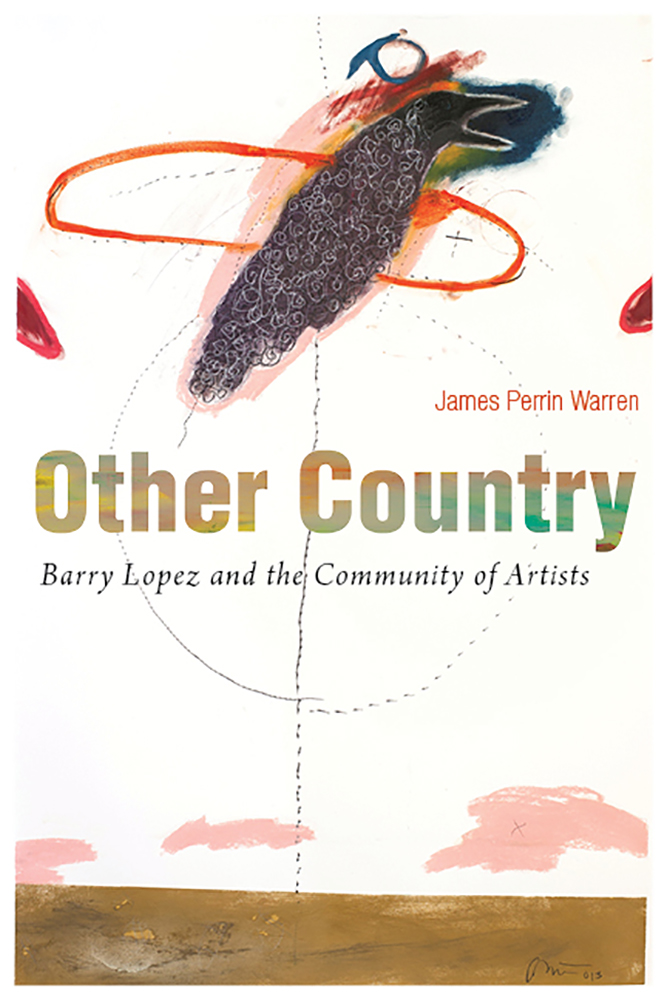Other Country
Barry Lopez and the Community of Artists
Hardcover ($52.00), Ebook ($52.00)
Buy
The award-winning American environmental writer Barry Lopez has traveled extensively in remote and populated parts of the world. Lopez’s fiction and nonfiction focus on the relationship between the physical landscape and human culture, posing abiding questions about ethics, intimacy, and place.
Other Country presents a full-scale treatment of Lopez’s work. James Perrin Warren examines the relationship between Lopez’s writing and the work of several contemporary artists, composers, and musicians, whose works range from landscape photography, painting, and graphic arts to earth art, ceramics, and avant-garde music. The author demonstrates Lopez’s role in creating this community of artists who have led cultural change, and shows that Lopez’s writing—and his engagement with the natural world—creates an “other country” by redefining boundaries, rediscovering a place, and renewing our perceptions of landscapes.
Warren’s critique examines manuscripts and typescripts from the 1960s to the present, interviews with Lopez conducted from 2008 to 2013, and interviews with artists. Part 1 focuses on the relationship between Lopez’s storytelling, which he calls “a conversation with the land,” and Robert Adams’s landscape photography. For both Lopez and Adams, a worthy artistic expression serves the cultural memory of a community, reminding us how to behave properly toward other people and the land. Part 2 looks at the collaborative friendship of Lopez and visual artist Alan Magee, tracking the development of Lopez’s short stories through a consideration of Magee’s career. Part 3 moves farther afield, discussing Lopez’s relationship to Richard Long’s earth art, Richard Rowland’s ceramics, and John Luther Adams’s soundscapes.
Other Country reveals the dynamic relationships between Lopez, considered by many the most important environmental writer working in America, and the artistic community, who seek to explore the spiritual and ethical dimensions of an honorable and attentive relationship to the land and thus offer profound implications for the future of the planet.
Other Country presents a full-scale treatment of Lopez’s work. James Perrin Warren examines the relationship between Lopez’s writing and the work of several contemporary artists, composers, and musicians, whose works range from landscape photography, painting, and graphic arts to earth art, ceramics, and avant-garde music. The author demonstrates Lopez’s role in creating this community of artists who have led cultural change, and shows that Lopez’s writing—and his engagement with the natural world—creates an “other country” by redefining boundaries, rediscovering a place, and renewing our perceptions of landscapes.
Warren’s critique examines manuscripts and typescripts from the 1960s to the present, interviews with Lopez conducted from 2008 to 2013, and interviews with artists. Part 1 focuses on the relationship between Lopez’s storytelling, which he calls “a conversation with the land,” and Robert Adams’s landscape photography. For both Lopez and Adams, a worthy artistic expression serves the cultural memory of a community, reminding us how to behave properly toward other people and the land. Part 2 looks at the collaborative friendship of Lopez and visual artist Alan Magee, tracking the development of Lopez’s short stories through a consideration of Magee’s career. Part 3 moves farther afield, discussing Lopez’s relationship to Richard Long’s earth art, Richard Rowland’s ceramics, and John Luther Adams’s soundscapes.
Other Country reveals the dynamic relationships between Lopez, considered by many the most important environmental writer working in America, and the artistic community, who seek to explore the spiritual and ethical dimensions of an honorable and attentive relationship to the land and thus offer profound implications for the future of the planet.
“Other Country will be of use to scholars and interested readers alike, taking them further into the other country Lopez’s work captures.”—Western American Literature
“Warren provides an original, eye-opening perspective on how Lopez has joined the call for a spiritual and ethical solution to the global environmental crisis”—Choice Connect
“This book places Lopez in relation to a specific community of artists, in historical time, and with political impact. It examines his work on an interdisciplinary level and connects it with visual media in a manner that is very timely for us today. I found myself learning many new things about Lopez’s connection to photography and other arts.”—Cory Lee Lewis, co-editor of The Pacific Crest Trailside Reader, California: Adventure, History, and Legend on the Long-Distance Trail
“The book argues how the idea of a community of artists upholds and sustains creative work that explores the spiritual and ethical dimensions of an honorable, attentive relationship to the land that has profound implications for the future of civilization in North America.”—John A. Tallmadge, series co-editor of Under the Sign of Nature: Explorations in Ecocriticism
“Warren provides an original, eye-opening perspective on how Lopez has joined the call for a spiritual and ethical solution to the global environmental crisis”—Choice Connect
“This book places Lopez in relation to a specific community of artists, in historical time, and with political impact. It examines his work on an interdisciplinary level and connects it with visual media in a manner that is very timely for us today. I found myself learning many new things about Lopez’s connection to photography and other arts.”—Cory Lee Lewis, co-editor of The Pacific Crest Trailside Reader, California: Adventure, History, and Legend on the Long-Distance Trail
“The book argues how the idea of a community of artists upholds and sustains creative work that explores the spiritual and ethical dimensions of an honorable, attentive relationship to the land that has profound implications for the future of civilization in North America.”—John A. Tallmadge, series co-editor of Under the Sign of Nature: Explorations in Ecocriticism
 The University of Arizona Press
The University of Arizona Press

